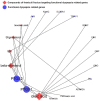Analysis of Network Pharmacological Efficacy and Therapeutic Effectiveness in Animal Models for Functional Dyspepsia of Foeniculi fructus
- PMID: 37375548
- PMCID: PMC10301275
- DOI: 10.3390/nu15122644
Analysis of Network Pharmacological Efficacy and Therapeutic Effectiveness in Animal Models for Functional Dyspepsia of Foeniculi fructus
Abstract
For centuries, Foeniculi fructus (F. fructus) has been used as a traditional herbal medicine in China and Europe and is widely used as a natural therapy for digestive disorders, including indigestion, flatulence, and bloating. The mechanism of F. fructus that alleviates functional dyspepsia was analyzed through network pharmacology, and its therapeutic effect on an animal model of functional dyspepsia were investigated. The traditional Chinese medicine systems pharmacology (TCMSP) database was used to investigate the compounds, targets, and associated diseases of F. fructus. Information on the target genes was classified using the UniProtdatabase. Using the Cytoscape 3.9.1 software, a network was constructed, and the Cytoscape string application was employed to examine genes associated with functional dyspepsia. The efficacy of F. fructus on functional dyspepsia was confirmed by treatment with its extract in a mouse model of loperamide-induced functional dyspepsia. Seven compounds targeted twelve functional dyspepsia-associated genes. When compared to the control group, F. fructus exhibited significant suppression of symptoms in a mouse model of functional dyspepsia. The results of our animal studies indicated a close association between the mechanism of action of F. fructus and gastrointestinal motility. Based on animal experimental results, the results showed that F. fructus provided a potential means to treat functional dyspepsia, suggesting that its medical mechanism for functional dyspepsia could be described by the relationship between seven key compounds of F. fructus, including oleic acid, β-sitosterol, and 12 functional dyspepsia-related genes.
Keywords: Foeniculi fructus; TCMSP; functional dyspepsia; network pharmacology; traditional medicine.
Conflict of interest statement
The authors declare no conflict of interest.
Figures









Similar articles
-
[Mechanism of Liangfu Pills in treatment of functional dyspepsia: based on network pharmacology and experimental verification].Zhongguo Zhong Yao Za Zhi. 2022 Jul;47(14):3853-3862. doi: 10.19540/j.cnki.cjcmm.20211230.705. Zhongguo Zhong Yao Za Zhi. 2022. PMID: 35850844 Chinese.
-
Network pharmacology-based screening of the active ingredients and mechanisms of evodiae fructus anti-glioblastoma multiforme.Medicine (Baltimore). 2022 Sep 30;101(39):e30853. doi: 10.1097/MD.0000000000030853. Medicine (Baltimore). 2022. PMID: 36181021 Free PMC article.
-
Maillard Reaction Products of Stir Fried Hordei Fructus Germinatus Are Important for Its Efficacy in Treating Functional Dyspepsia.J Med Food. 2020 Apr;23(4):420-431. doi: 10.1089/jmf.2019.4430. Epub 2020 Jan 22. J Med Food. 2020. PMID: 31971858
-
[Mechanism of Xiaoyao San in treatment of depression,breast hyperplasia,and functional dyspepsia based on network pharmacology].Zhongguo Zhong Yao Za Zhi. 2021 Aug;46(16):4230-4237. doi: 10.19540/j.cnki.cjcmm.20210520.702. Zhongguo Zhong Yao Za Zhi. 2021. PMID: 34467737 Chinese.
-
Exploration of the mechanism of Zisheng Shenqi decoction against gout arthritis using network pharmacology.Comput Biol Chem. 2021 Feb;90:107358. doi: 10.1016/j.compbiolchem.2020.107358. Epub 2020 Aug 8. Comput Biol Chem. 2021. PMID: 33243703 Review.
Cited by
-
Simultaneous Analysis of Thirteen Compounds in Yeokwisan Using High-Performance Liquid Chromatography-Photodiode Array Detection and Ultra-Performance Liquid Chromatography-Tandem Mass Spectrometry and Their Antioxidant Effects.Pharmaceuticals (Basel). 2024 Jun 4;17(6):727. doi: 10.3390/ph17060727. Pharmaceuticals (Basel). 2024. PMID: 38931394 Free PMC article.
-
Unraveling the Therapeutic Mechanism of Saussurea involucrata against Rheumatoid Arthritis: A Network Pharmacology and Molecular Modeling-Based Investigation.Nutrients. 2023 Oct 9;15(19):4294. doi: 10.3390/nu15194294. Nutrients. 2023. PMID: 37836578 Free PMC article.
-
Lacticaseibacillus paracasei HP7 Improves Gastric Emptying by Modulating Digestive Factors in a Loperamide-Induced Functional Dyspepsia Mouse Model.J Microbiol Biotechnol. 2025 Mar 11;35:e2412035. doi: 10.4014/jmb.2412.12035. J Microbiol Biotechnol. 2025. PMID: 40081888 Free PMC article.
-
Effectiveness and safety of Chinese herbal footbaths as an adjuvant therapy for dysmenorrhea: a systematic review and meta-analysis.Front Pharmacol. 2024 Aug 5;15:1397359. doi: 10.3389/fphar.2024.1397359. eCollection 2024. Front Pharmacol. 2024. PMID: 39161905 Free PMC article.
-
Therapeutic Effects of Zanthoxyli Pericarpium on Intestinal Inflammation and Network Pharmacological Mechanism Analysis in a Dextran Sodium Sulfate-Induced Colitis Mouse Model.Nutrients. 2024 Oct 17;16(20):3521. doi: 10.3390/nu16203521. Nutrients. 2024. PMID: 39458516 Free PMC article.
References
MeSH terms
Substances
Grants and funding
LinkOut - more resources
Full Text Sources
Medical

